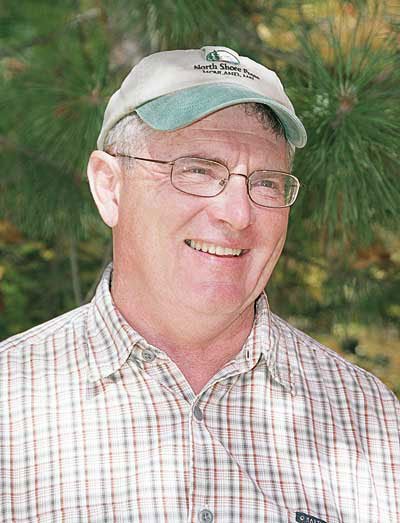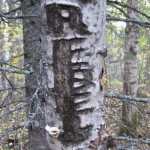Seeing the lake was a matter of luck, just a glimpse of water through the trees. It wasn’t very far from the faded old logging road. I pushed through a hundred yards of tangled moose maples and stepped out on the shore of a mirror-still lake, ringed with golden aspen and ancient white pine. The day was nearly done and the sun was low over the trees.
The October day was impossibly warm; no doubt my last fleeting taste of summer. Even though I had a fairly long hike back to the truck, I sat down on a fallen log to take a break and savor the moment. Two hot and tired dogs went swimming in the lake. Not a soul was anywhere near this lake, which probably receives no more than a handful of human visitors in a year. Surrounded by splendid solitude and breath-taking natural beauty, I felt like the richest man in the world.
Living where I do on the North Shore of Lake Superior, in a county containing over 90 percent public land, it is easy to take such moments for granted. But I spend enough time in other places to never do so. Anytime you get away, you have an opportunity to appreciate what you have back home.
Most recently I was in Montana, a state that describes itself as “the last best place.” Montana is awfully nice, but I discovered some of those best places are rather hard to reach. In short, access to the state’s public lands and waters, while good, tends to concentrate people near the access points. Miles of a public trout stream, for instance, may be accessed only where a bridge crosses a public road. In the mountains, sprawling wilderness areas may be accessed from a handful of trailheads with huge parking lots. To find solitude, you have to elbow your way through the crowd.
Yet, by most any measure, public access in Montana would rate as excellent. The state clearly places a priority on providing access to its many “last best places.” Decades of effort have gone into creating the access points that exist, as well as defending the public’s right to use public waters and lands from those who try to take it away. In short, Montana’s extensive network of public access sites didn’t come easy.
The same is true here in Minnesota, even though we tend to take our public access to lakes and lands for granted. We ought to be proud that nearly every fishing lake in the state has a public access and very often a concrete pad to launch your boat. We shouldn’t sell short the extensive system of state Wildlife Management Areas that allow anyone who purchases a hunting license and stamps, the opportunity to find quality public hunting. We also have state parks, biking trails, snowmobile trails and so much more.
Most of us rarely think about public access any more than to know where it is and what it allows us to do. For a moment, let’s ponder the bigger picture. Without public access to our lands and waters, would we have any outdoor recreation? How many of us would be anglers if you had to own land on a lake in order to go fishing there? What would participation in Minnesota pheasant hunting be like if there were no Wildlife Management Areas? Would outdoor-oriented box stores and the companies that sell products in them even exist? Without public access, outdoor recreation and the industry it supports may have never developed to anywhere near extent of what exists today.
No one waved a magic wand and created all of the public access sites available to us. Instead they were built one site at a time. This work has gone on for nearly a century. In the 1930s, the Civilian Conservation Corps worked on sites that are still in use today. In Minnesota, visionaries such as the late Dave Vesall, the Fish and Wildlife director whose Save the Wetlands campaign forged the start of the Wildlife Management Area system, and the late Joe Alexander, the DNR commissioner vowed to have a public access on every lake, set into motion access programs that have benefitted millions of people.
While the majority of public access sites can be used free-of-charge, building an access isn’t free. Always there are costs for land acquisition and site development. Paying these costs is very often a matter of cobbling together various funding sources. Depending on the site, the money may come from federal, state and local governments as well as private sources. Getting money from one source is often dependent on receiving money from another, especially to qualify for government funding.
Unfortunately, one of the primary sources of federal funding for public access and outdoor recreation just dried up, because Congress failed to do its job. The 50-year-old Land and Water Conservation Fund, which is funded with oil and gas royalties from offshore drilling, was allowed to lapse for the first time in its history despite bipartisan support in the House and Senate. The reason is because one man, Rep. Ron Bishop (R-UT), chair of the House natural Resources Committee, refused to give the bill a hearing. He has said in a press release that he will block all attempts to reauthorize the fund unless Congress—and by extension everyone who enjoys outdoor recreation in America—submit to his demands to siphon the money for purposes which have little or nothing to do with public access and outdoor recreation.
Bishop is what used to be called a Sagebrush Rebel, belonging to a political sect intent on transferring our public lands to the highest bidder. Since the LWCF is a primary source of funding for acquiring public lands for parks and recreation, eliminating it is a shot to the vitals of everything from national parks to the soccer field where your kids play. Over the last 50 years, LWCF has provided funding for projects in virtually every community across the nation. Now, one guy has decided to kill the fund because he thinks he has a better idea. Funny, but I’ve got a feeling that millions of America’s outdoor lovers may disagree.




